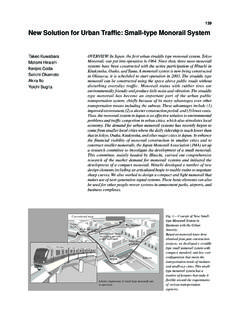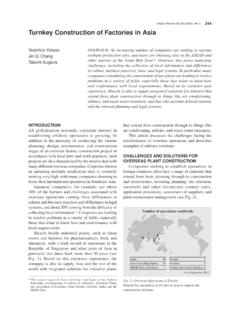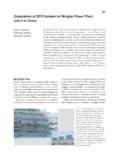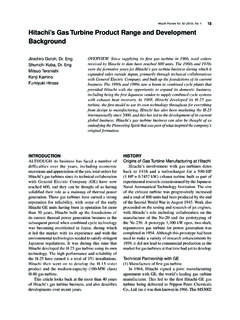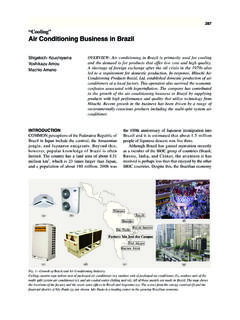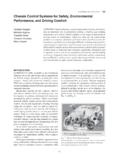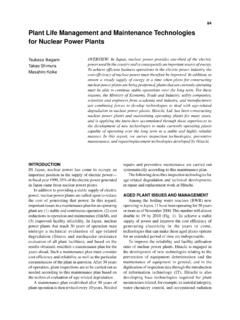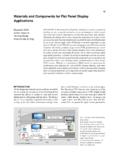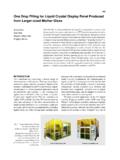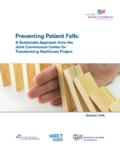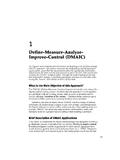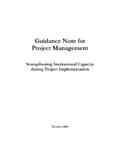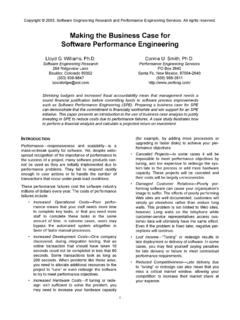Transcription of Approach to Overseas EPC Project - Hitachi Global
1 Approach to Overseas EPC Project 98 Approach to Overseas EPC Project Technical Features of MidAmerican Project in the OVERVIEW: Hitachi has been awarded a contract for an Overseas EPC(engineering, procurement and construction) Project . This opportunity hasprovided us with a wealth of experience. In February 2003, Hitachi wasasked by MidAmerican Energy Company in Iowa , through Mitsui &Co. Energy Development, Inc., to execute the EPC of the Council BluffsEnergy Center, Unit 4, an 870-MW (gross) capacity power plant. This is thefirst large-capacity coal-fired EPC Project for Hitachi in the This paperdescribes the technical features of the Council Bluffs Energy Center, Unit 4project. This plant adopts PRB (powder river basin) coal-fired super criticalonce-through, sliding pressure, BHK (Babcock- Hitachi )-type Bensonboiler under steam condition of MPa g, 566/593 C, a four-flow tandemcompound turbine, with long 40-inch last stage blades, the largest-classtwo-pole generator, and cooling towers for circulating water.
2 In addition,we adapted a De-NOx unit, a DFGD (dry flue gas desulfurization) unit, andhighly efficient fabric-filter dust bags to satisfy the environmental established a construction team to complete the plant within 45months from the NTP (notice to proceed) to the S/C (substantial completion)phases. Advanced supercritical technology coal-fired power plants havenot been constructed in the US. for at least 20 years. Working in closecooperation with MidAmerican Energy Company, the construction is nowin TateishiHidetoshi FujiiTomoshige KogaHajime KimuraINTRODUCTIONBASED on its accumulated expertise and practicalexperience, Hitachi was awarded an EPC (engineering,Fig. 1 Photo of Project Constructionin Progress, May steel frame construction isalmost completed, and condenserinstallation work is now in and construction) contract to build theCouncil Bluffs Energy Center s Unit 4, a highlyefficient 870-MW (gross) capacity coal-fired powerHitachi Review Vol.
3 54 (2005), No. 3 991 summarizes the main scope of work is summarized as follows:(1) Turbine island(a) Turbine-generator(b) Condensate system (condenser, extractionpumps, vacuum pumps, polisher, etc.)(c) Feedwater heating system (pumps, feedwaterheater, deaerator, etc.)(d) Electrical, instruments, and control(2) Boiler island(a) Boiler proper (burner, superheater, etc.)(b) Ash handling system(c) Coal handling system(3) Air quality control island(a) De-NOx system(b) Flue gas desulfurization unit(c) Fabric filter(4) BOP (balance of plant)(a) Well and well pumps(b) Well water clarifier(c) Water treatment unit(5) Civil engineering and architecture(a) Turbine building(b) Boiler building(c) Administration building(d) Warehouse(e) Maintenance building(f) Stackplant (see Fig. 1). The construction of Unit 4commenced in September 2003.
4 Erection of thestructural steel boiler started in June 2004 and theconstruction is progressing. This paper describes thetechnical features of the turbine, generator, boiler,AQCS (air quality control system), and OVERVIEW AND TECHNICALFEATURESMidAmerican Energy Company is the largest utilitycompany in Iowa. Council Bluffs Energy Center, Unit4 is located in Council Bluffs, as shown in Fig. 2. TableFig. 2 Location of Council Bluffs City, plant is located on the outskirts of Council Bluffs in thestate of Iowa in the 1. Main Power Plant DesignSpecificationsBasic design conditions and keyspecifications for the boiler, turbine,and generator are : powder river basinCouncil Bluffs, IowaBasic design conditionsKey conditionsRated output Steam conditions FuelBoilerTurbineGeneratorTypeSteam pressureSteam temperatureMax. continuous rating Type Rotational speedCondenser vacuumTypeCapacityMWMPa g C MPa g Ct/h r/minmmHg MVAUnit870 (gross) (PRB coal)Supercritical once-through boiler with sliding pressure operation ,530 Tandem compound 4-flow exhaust3,600722 Cylindrical rotor type,synchronous alternator1,025 Council BluffsEnergy Center, Unit 4 ItemApproach to Overseas EPC Project 100 GENERATORF eatures of GeneratorThe generator for the MidAmerican Project is ratedat 1,025-MVA which is among the largest Hitachi two-pole generators designed for thermal power plants.
5 Thecapacity of this generator is one of the largestgenerators that have ever been manufactured in ourfactory. Development of this generator is based on ouradvanced technology as well as a well-verified TechnologiesIn Table 2, the technologies used to obtain largecapacity generators are shown. Some examples aredescribed as general, the generator output increases inproportion to the square of the rotor diameter. Thestress in the rotor part increases in a similar , a high strength and fracture resistant rotorshaft material is required under high-stress we developed and applied the high-tensile-strength (1,000-N/mm2 class) rotor materials. Thismaterial has high purity and high-tensile strength,without segregation and embrittlement, because it isdeacidified by vacuum treatment and ladle need to improve the gas cooling ability inextremely large capacity generators because hugeFig.
6 3 40-inch (about 102-cm) Last Stage Blade (a), (about 85-cm) Last Stage Blade (b) with CCB(continuous cover blade) Construction for 60 Hz steam turbine for this Project uses 40-inch last stage 4 High-pressure Turbine Blades with are interconnected by tip TURBINES tructure of Steam TurbineThe electrical output of the steam turbine unit forthis Project is 870 MW, which is the largest Hitachisteam turbine produced for service outside of turbine layout is TCDF-40 [tandem compounddouble flow with 40-inch LSBs (last stage blades)].Fig. 3 shows the 40-inch (about 102-cm) Specifications of Steam TurbineHigh-temperature material was used in the primaryparts of the steam turbine to meet the high thermalconditions (main steam pressure: MPa g, mainsteam/reheat steam temperature: 566/593 C).For example, we used 9 Cr-forged steel for thefollowing parts: body of main stop valve, main steamcontrol valve, and combined reheat valve,main &reheat steam lead , 12-Cr steel was used in the followingparts: HP/IP rotors, HP/IP internal casings, anddiaphragm for HP/IP improve efficiency and reliability, we applied aCCB in the moving blades in the HP & LP (highpressure & low pressure) sections of the turbine.
7 Shows a typical HP rotor with CCB-type improve efficiency, an AVN (advanced vortexnozzle) was used in the nozzle blades in each sectionof the turbine.(a)(b) Hitachi Review Vol. 54 (2005), No. 3 101losses occur. Therefore, we used g hydrogenfor better cooling, the same as is used in four-poletype large turbine generators (1,500-MVA class). Thecoolers are not the vertical type that is standard in two-pole generators, but the top dome type commonly usedin four-pole type generators, which enabled us to obtaina compact stator frame structure. In addition, wedirectly cooled the rotor windings using hydrogen andthe stator windings using water to achieve highreliability, as done in other large AND AQCSB oiler EquipmentThe furnace of boiler was designed for PRB(powder river basin) coal, where the ash slaggingcharacteristics are extremely demanding.
8 PRB coal ashis glassy and hard, and difficult to remove from thefurnace efficiently using conventional steam or airblowers. We plan to install water-cannon type ashremoval equipment, considering the furnace monitoring the heat flux in each part of the furnacewater wall, the dirty parts can be effectively cleanedusing water cannon type removal by changing thewater flow direction. This cleaning system reduces thetemperature rise of the furnace exit gases during PRBcoal firing. In the combustion system, the largecapacity new Hitachi -NR3 burner uses an in-flameNOx reduction system with a high temperaturereducing flame. The burner combustion and two-stageAAP (after air port) combustion enables us to reduceFig. 5 Cross-sectional View ofCouncil Bluffs Energy Center, Unit design closely follows the latestlarge-capacity supercritical Bensonboiler 2.
9 Technical Issues andApplied Technologies for LargeCapacity generatorTechnologies overcoming thechallenges of increased capacity(increased current and size) wereapplied to the 1,025-MVA currentIncreased sizeStator winding coolingStator winding end support structureStator core end structure Rotor winding coolingH2 gas cooler structure BushingRotor shaft materialEnd-ring material Rotor vibration Rotor cross-sectional shape Stator frameLarge diameter bearingsMixed strand stator windingStructure with non-separated water path from current pathWater cooling for connector separated from windingsLarge-diameter insulation hoseTetra-lock structureShield core, copper-plate shieldDirect H2 cooling field lead Top dome cooler structureHydrogen direct cooling bushingHigh-strength and fracture toughness materialHigh-strength 18Mn-18Cr steelReduction of vibration sensitivity Stress reduction through optimum designCompact frameElliptic bearing with central groove Applied technologiesTechnical issues mSteam separatorSecondary superheaterTertiary superheaterSecondary reheaterPrimary reheaterPrimary superheaterFuel economizerDeNOxAir preheaterFurnace slagging countermeasures Adopt large furnace Water-cannon type ash removal equipment Low NOx combustion technology Hitachi -NR3 burner Two-stage combustion using over-air portsApproach to Overseas EPC Project 102* U2A is a trademark or a registered trademark of Wahlco, in exhaust side view of this boiler is shown in Fig.
10 5. Theboiler design is based on the latest technology for largecapacity supercritical pressure Benson boilers,established in domestic plants in satisfy the environmental regulations, the AQCS consists of a De-NOx and DFGD (dry flue gasdesulfurization) system, as shown in Fig. 3 shows the specifications of the SCR(selective catalytic NOx reduction) system. The PRBcoal contains high calcium and high catalyst poisons,and the dust easily sticks to the catalyst. This SCRsystem uses a Hitachi plate-type catalyst that has ahigher resistance to dust plugging and has beenmodified to achieve higher durability in PRB-fired catalyst reactor is designed to be compact, withspecial flue-gas mixers upstream of the reactors. Thismixer accelerates NH3 mixing with the flue gases fora short residence time. This SCR system operates usinga harmless urea instead of the toxic NH3 normally urea process has been applied in SCR systems inthe since 2000, due to the safety requirements oftoxic substance handling.
